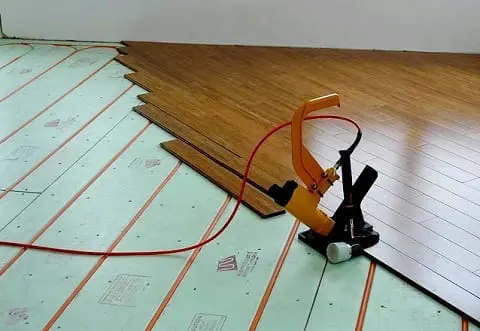
Radiant flooring, also known as underfloor heating, is an increasingly popular home heating solution that provides warmth from the ground up. This method is praised for its efficiency and comfort, making it a valuable addition to modern homes.
On days where the thought of leaving the sanctuary of your warm bed is almost unbearable, radiant flooring can be the right choice. Instead of touching down on an ice-cold floor, your toes will make contact with a warm, cozy surface. Sounds pretty great, doesn’t it?
To help us sift through the pros and cons of radiant flooring, we’ve enlisted the help of both experts and homeowners:
Types of Radiant Flooring
Radiant flooring systems come in two primary types known as hydronic and electric.
Hydronic systems are water based. This system uses heated water that circulates through a network of tubes or pipes embedded in the floor. The water is heated by a boiler or a water heater and is pumped through the tubes, radiating heat upward. It can be installed in various floor types, including concrete slabs, beneath subfloors, or over existing floors with a low-profile system.
Installation costs range from $6 to $20 per square foot, depending on the complexity of the installation and the type of system.
Electric systems utilize electric heating cables or mats installed beneath the floor surface. The cables are connected to a thermostat and generate heat when electricity flows through them.
Electric systems are often easier and quicker to install compared to hydronic systems. They are typically used in smaller areas like bathrooms or kitchens.
Installation costs range from $8 to $15 per square foot. They are less expensive to install but can be more costly to operate due to electricity prices.
Benefits of Radiant Flooring
Even heating is discovered with radiant flooring. There is a consistent, even heat distribution across the entire floor, eliminating cold spots.
These systems can be more energy-efficient than traditional heating methods because they require lower temperatures to achieve the same comfort level.
Experience comfort: when walking on warm floors, especially in cold climates. Radiant flooring enhances overall comfort and coziness in a home.
Aesthetic flexibility is evident in this invisible system. It won’t interfere with interior design like radiators and vents can.
Unlike forced-air systems, radiant flooring operates silently, providing a peaceful environment.
With no forced air circulation, there’s less dust and allergens being moved around, improving indoor air quality.
Efficient Comfort
Radiant floor heating offers competitive pricing, low installation costs, and energy efficiency, potentially saving homeowners up to 30% compared to forced air systems. Waves of infrared radiation rise up through the floor, resulting in less heat lost to surrounding surfaces and even heating throughout the area. “There’s no blowing air, no noise, no hot and cold areas — heat goes where you go,” says Ross McCord, brand manager at Warmboard, Inc.
Radiant flooring also improves your indoor air quality because there’s no forced circulation. “You can actually significantly reduce or eliminate instances of asthma while limiting the transmission of airborne viruses,” McCord adds.
Payoffs
Radiant flooring can reduce heating bills by 10-30% due to its efficiency. The exact savings depend on factors such as the type of system, insulation quality, and energy costs.
Installing radiant flooring can enhance your home’s value, appealing to potential buyers looking for modern, efficient heating solutions.
While the initial cost is high, the long-term savings on energy bills and increased home comfort can make it a worthwhile investment. Hydronic systems, in particular, tend to have lower long-term operational costs.
Drawbacks
Despite all the wonderful things about radiant flooring, there are some disadvantages. “Radiant heating can take a while for you to feel the effects — it is a slow-building system,” says Michael Kenealy, founder and CEO of REDRHINO Flooring. In other words, if you live in an area with rapid temperature changes, your radiant flooring system might be slow to adjust.
“What I tell my clients is that the comfort of a warm floor on a cold day can’t be matched, but it is not a system that you can set and forget about,” says Ryan Thewes, an architect in Nashville, Tenn. “You have to be active with it and on top of what the weather is going to be like in the next few days. Otherwise, it will be your enemy.”
Installation costs can be significant, especially for hydronic systems, due to the complexity and labor involved. Installing radiant flooring can be time-consuming, particularly if retrofitting an existing home.
Some flooring materials, like thick carpets, may not be suitable for radiant heating systems as they can insulate against the heat. Adding radiant flooring may raise the floor height, which can be problematic with doors and thresholds.
Once installed, accessing the system for repairs can be challenging and potentially costly.
Homeowner Mary Maynard, currently living in her second home with radiant flooring, shared her key advice: “It’s very important to hire a very experienced contractor — the systems can be complicated, and you want yours to work correctly.”
Radiant flooring offers a luxurious and efficient heating solution with numerous benefits. Evaluating your specific needs, budget, and long-term plans can help determine if radiant flooring is the right investment for your home. For those looking to enhance comfort and efficiency, the long-term benefits often outweigh the initial costs, making radiant flooring a smart and valuable addition to modern living spaces.